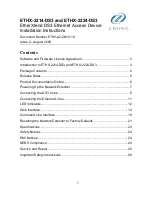
DRA-2 UNIVERSAL COMMUNICATION NODE
58/158
USER GUIDE - Rev.5 (January 2018)
•
Tunnel Source
. This establishes the local interface through which the tunnel traffic
will be routed. In the case of WAN (GPRS/UMTS) interfaces, it may be
cell0-0
(identifies SIM A) or
cell0-1
(identifies SIM B). Otherwise, it will be a virtual network
identifier from one of the VLANs in the equipment.
•
Remote GW
. This establishes the IP address of the equipment at the other end of
the tunnel, that is to say, the terminator.
•
Remote network
. The remote subnetwork connected to the point at the end of the
tunnel (Remote GW) whose traffic passes through the tunnel. If
any
is selected, all
traffic not accessible locally or based on specific rules will be sent through the
tunnel.
•
Enable.
This permits a tunnel to be enabled or disabled, by ticking or not ticking
the respective
Enable
box.
•
Tunnel description.
A descriptive field permitting the indication of data about the
tunnel, for example, its usefulness.
•
Preshared key.
A key that is exchanged between the equipment at both ends of
the tunnel, for the purpose of establishing it. It must be configured in both
terminators (Tunnel IP and Remote GW). For it to be effective, the associated
Enable
box must be ticked.
Example:
An example is given below which allows the different parameters referred to above to be
identified, with specific values. The GRE tunnel is established between Routers A and B,
connected through an IPv4 network; the connection could well be the Internet.
Routers A and B route the traffic between the equipment belonging to Group 1 and Group 2
as if both routers were directly connected to each other, since they both have an IP address
in the same segment, 10.1.2.1 and 10.1.2.2 respectively, which are the IP addresses
assigned locally to each end of the tunnel; they do this in a transparent manner on the IPv4
network.
















































